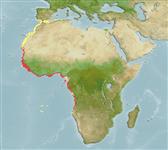>
Eupercaria/misc (Various families in series Eupercaria) >
Sparidae (Porgies)
Etymology: Pagellus: Diminutive of Latin, pager, derived from Greek, pagros = a fish, Dentex sp. (Ref. 45335).
Eponymy: Cristoforo Bellotti (1823–1919) was an Italian ichthyologist and palaeontologist, who was also very interested in the breeding of silkworms. [...] (Ref. 128868), visit book page.
More on author: Steindachner.
Environment: milieu / climate zone / rango de profundidad / distribution range
Ecología
marino demersal; rango de profundidad 100 - 250 m (Ref. 27000), usually 10 - 50 m (Ref. 5377). Subtropical; 37°N - 17°S, 19°W - 14°E
Eastern Atlantic: Strait of Gibraltar to Angola, including the southwestern Mediterranean (Ref. 3469) and the Canary Islands.
Length at first maturity / Tamaño / Peso / Age
Madurez: Lm 12.2 range ? - ? cm
Max length : 42.0 cm SL macho / no sexado; (Ref. 4781); common length : 25.0 cm SL macho / no sexado; (Ref. 4781)
Short description
Claves de identificación | Morfología | Morfometría
Espinas dorsales (total) : 12.
Body shape (shape guide): fusiform / normal.
Occurs in schools over hard as well as sandy bottoms, especially in the upper 100 m. Omnivorous with a predominantly carnivorous diet (including crustaceans, cephalopods, small fish, amphioxus and worms). Protogynic hermaphrodite (Ref. 3688). Minimum depth reported taken from Ref. 127989.
Intermittent spawning occurs from the second year onwards between May and November according to the latitude, the stock moving toward the coast for this purpose.
Bauchot, M.-L. and J.-C. Hureau, 1990. Sparidae. p. 790-812. In J.C. Quero, J.C. Hureau, C. Karrer, A. Post and L. Saldanha (eds.) Check-list of the fishes of the eastern tropical Atlantic (CLOFETA). JNICT, Lisbon; SEI, Paris; and UNESCO, Paris. Vol. 2. (Ref. 3688)
IUCN Red List Status (Ref. 130435: Version 2025-1)
Threat to humans
Harmless
Human uses
Pesquerías: comercial
Herramientas
Special reports
Download XML
Fuentes de Internet
Estimates based on models
Preferred temperature (Referencia
123201): 18.5 - 28, mean 25.2 °C (based on 140 cells).
Phylogenetic diversity index (Referencia
82804): PD
50 = 0.5156 [Uniqueness, from 0.5 = low to 2.0 = high].
Bayesian length-weight: a=0.01202 (0.00996 - 0.01451), b=3.04 (3.01 - 3.07), in cm total length, based on LWR estimates for this species (Ref.
93245).
Nivel trófico (Referencia
69278): 4.0 ±0.51 se; based on food items.
Generation time: 4.6 (2.5 - 6.1) years. Estimated as median ln(3)/K based on 10
growth studies.
Resiliencia (Referencia
120179): Medio, población duplicada en un tiempo mínimo de 1.4-4.4 años (K=0.18-0.53; tm=1; tmax=7; Fec=60,200).
Prior r = 0.82, 95% CL = 0.54 - 1.23, Based on 2 data-limited stock assessments.
Fishing Vulnerability (Ref.
59153): Moderate vulnerability (43 of 100).
🛈
Climate Vulnerability (Ref.
125649): Low to moderate vulnerability (26 of 100).
🛈
Nutrients (Ref.
124155): Calcium = 164 [78, 347] mg/100g; Iron = 0.706 [0.391, 1.313] mg/100g; Protein = 20.2 [19.0, 21.5] %; Omega3 = 0.414 [0.235, 0.701] g/100g; Selenium = 69.8 [27.3, 173.0] μg/100g; VitaminA = 7.84 [1.97, 34.79] μg/100g; Zinc = 0.462 [0.311, 0.735] mg/100g (wet weight);
